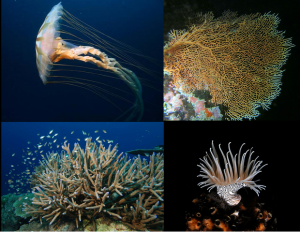Cnidaria
Higher classification: Animal
Kingdom: Animalia
Subkingdom: Eumetazoa
Class:ParaHoxozoa
Phylum:Cnidaria
- Cnidaria is a phylum under kingdom Animalia containing over 11,000 species of aquatic animals found both in freshwater and marine environments, predominantly the latter. Their distinguishing feature is cnidocytes, specialized cells that they use mainly for capturing prey.
- Mostly marine entities while few such as hydra are found in freshwater
- While some are solitary (sea anemone) some others are colonial (Corals)
- Depict a tissue grade of organization and are diploblastic
- Members exhibit radial symmetry, however sea anemones exhibit biradial symmetry
- Body wall comprises an outer epithelium referred to as epidermis and inner epithelium referred to as
 gastrodermis. There is a gelatinous mesoglea found between the inner and outer epidermis
gastrodermis. There is a gelatinous mesoglea found between the inner and outer epidermis- There are two different forms of cnidarians – Polyp and medusa. Polyp is hydroid form, sessile with mouth-up orientation. The medusa is bell or umbrella shaped with mouth down alignment
- Mesoglea comprises amoeboid cells which come from the ectoderm. The mesoglea in polyps is thin and thick in medusa, essential for buoyancy
- Body wall comprises stinging cells referred to as cnidocytes. Each of the cnidocyte cells comprises fluid filled membranous capsules – cnida. Cnidocytes are functional in defending and capturing prey
- They possess a blind sac-like central cavity referred to as gastrovascular cavity or coelenterons which opens out by the mouth surrounded by tentacles. Mouth is functional in ingestion and egestion. Coelenterons helps in digestion and circulation
- Through the process of diffusion across the body wall, there is exchange of respiratory gases and elimination of excretory wastes takes place
- Neurons are connected, forming a pair of nerve nets – one in the gastrodermis and the other in the epidermis. Nerve impulses travel in any direction. Along with nerve nets, the medusae have ganglia and nerve rin
- gs surrounding the margin of the bell
- In the medusoid form, sensory structures (statocysts) occur
- Asexual reproduction is by fission, budding and fragmentation
- Generally unisexual however some are bisexual. External fertilization occurs, and cleavage is holoblastic. Indirect development and includes a free swimming ciliated larval stage referred to as planula
- The alternation of asexually reproducing polyp form in species having polyp and medusa phases and in sexually reproducing medusa form is referred to as metagenesis
- They exhibit regeneration
-
There are four major groups of cnidarians:
- Anthozoa, which includes true corals, anemones, and sea pens;
- Cubozoa, the amazing box jellies with complex eyes and potent toxins;
- Hydrozoa, the most diverse group with siphonophores, hydroids, fire corals, and many medusae; and.
- Scyphozoa, the true jellyfish.
